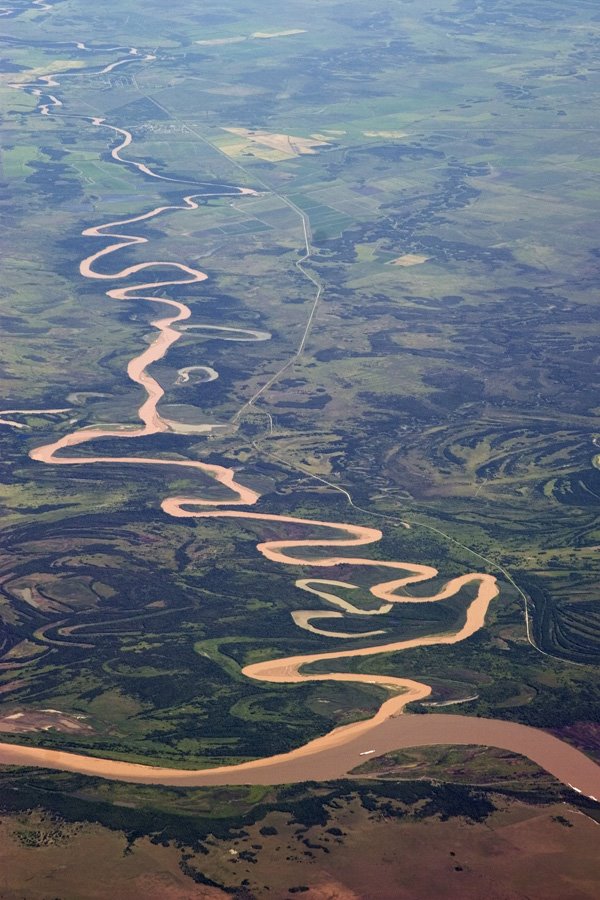Featured Image: Rio Bermejo meeting up with the Paraguay River, on the boarder of Formosa and Chaco Provinces. Image by Mapio. Used with permision.
Paper: Fluvial organic carbon cycling regulated by sediment transit time and mineral protection
Authors: Marisa Repasch, Joel S. Scheingross, Niels Hovius, Maarten Lupker, Hella Wittmann, Negar Haghipour, Darren R. Gröcke, Oscar Orfeo, Timothy I. Eglinton, and Dirk Sachse
In our current era of rapid climate change, it is critical we understand how every aspect of the Earth system affects carbon cycling. New work by Marisa Repasch and colleagues shows that rivers, under the right conditions, might be able to sequester more carbon in the sediments than released into the atmosphere. However, these findings may reveal how human impacts to rivers will likely increase the amount of carbon released to the atmosphere.
If you’ve ever peered into a murky river, you may have seen the tiny grains of sand and particles tumbling gently in the current while the larger particles stayed still. Over significant timescales, even the larger particles move down the river channel. How long this takes is called “sediment transit time”. Repasch and colleagues found that the main control on carbon cycling in rivers is the sediment transit time. As sediment transit time increases (such as in floodplain areas), microbes within the water and mud can digest the sediment particles, releasing carbon dioxide into atmosphere where it accelerates climate change.
However, the presence of metals such as iron, aluminum, manganese, and magnesium may crash the microbial party by protecting the carbon-containing particles. These solid metals may tightly bind to the particles, covering the surface in an impenetrable wall. This process is known as “mineral protection” since it protects the carbon in the particles from microbial consumption (and therefore prevents the release of carbon dioxide). The relationship between sediment transit time and mineral protection sets the overall release of carbon dioxide into the atmosphere in river systems: the faster sediment moves and/or the better protected it is, the more carbon will be buried in river basins rather than released to the atmosphere.
So how did the authors measure the presence, movement, and transformation of these particles? Certainly, this is a daunting task, and one that took place at the border of Paraguay and Argentina along 800 miles of the Rio Bermejo. In order to understand how the carbon within these particles transform, Repasch and colleagues identified the precise weights of each carbon atom. The weights will change in response to the number of neutrons (a sub-atomic particle) present, and atoms with greater or fewer neutrons than expected are known as isotopes. Given these complex interactions with Earth cycles over time, proportions of differing isotopes of carbon allow the researcher to reconstruct a larger picture of the carbon cycling process. For example, increased abundances of heavier carbon atoms indicate an input of carbon particles from vegetation.
Using their newly uncovered information, Repasch and colleagues then described the river system with an equation. They were able to apply this equation to the unknown, enabling them to better describe the natural system. This work may help us understand how human impacts (particularly levees, dams, and groins) greatly reduce sediment mobility and increase sediment transit time, leading to substantial impacts to carbon storage or release, regardless of the presence of metals. This work represents a direct application of measuring carbon-containing particles within rivers to human activities and global carbon cycling.
Perhaps next time you see a wide river you may consider the implications and role it plays in sequestering or releasing carbon dioxide. Large, murky rivers surrounded by human establishment and modifications are likely contributing more carbon dioxide to the atmosphere compared to a free-flowing, meandering river such as Rio Bermejo. Repasch and colleagues highlight the complexities of the natural carbon cycle and how it interacts and responds to human involvement. Theirs and future studies strengthen our understanding of nature and the continuing impacts of climate change.
The surprising effects rivers have on our atmosphere by Jessica Buser-Young is licensed under a Creative Commons Attribution-ShareAlike 4.0 International License.

